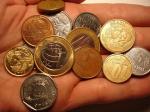
Money is such a big topic, I’ve been looking around for a metaphor that can free us, shift our understanding so that we can relate more powerfully to this vital resource.
As I look around me, I see many people who believe that money limits or enables the things they do with their lives. My view is different. I see money as a symptom, rather than a cause.
If we are afraid to step out and do what we are called to do, money steps in to protect us, usually by its scarcity – we can’t do what we “want” to do, it seems, because we haven’t got the money.
If we step out boldly, confident in making those dreams happen, money falls into line, either working well, or proving not to be necessary.
Money is always a symptom, never a cause.
I’ve been playing with the metaphor of money as being like air – we certainly need air to be creative: a lack of it stunts our creativity rapidly. What if we thought of money as we think of air, something we trust so much that we cease to think about it, breathing it in as we need it, breathing it out as we’re done with it, ready to take the next breath when it comes, knowing it will be there?
This goes some way towards freeing us of the “money as a limiting resource” idea, but I feel it misses something, relegates money to being a one-dimensional thing, a “have or have not” commodity, when the possibilities are so much more exciting.
What if we thought about money as an artist thinks about paint, and wielded it just as consciously? What if we saw that money has infinite facets and nuances and aspects to it, as paint has endless variety of colour and shade and texture?
Think of how an artist selects paint, going to an art supply store – shrines of sacred creativity, hushed and full of awe and vibrant life – and looks through all the varieties on offer. It is a creative act in itself, perhaps testing samples on paper, between fingers, revelling in the colours and the gloss of the fresh wetness, the jewel-like shine of light and highlight reflecting back the point-sources from the light fittings in the store, or the natural light filtering in the windows.
Imagine how artists explore fellow-artists’ supplies, the excited discussions when a new variety is found, poring over palette and canvas and tube.
Artists care very much about this raw material, and are very conscious of the quality they bring into their creations.
Then once the paint is selected, look at how they wield it. Art is not just about the paint, but about the subtleties of where and how it is placed on the canvas, how the colours interact, how the shapes form into what we perceive as images.
Think of how the artist feels as they work, and how that feeling translates intangibly into the result; the work of art holds the energy of the artist and the moment of creation, translated through atoms and molecules and shapes and textures, and the miraculous play of light on it all. In inspired works of art, the artist connects with their deep self, and the deeper consciousness of the universe, and transfers that energy into their work.
What if we consciously transferred our creative energy into our lives as we spend?
My point is that life could be magnificently enhanced if we poured this level of conscious awareness and connectedness into how we draw money into our lives, and how we spend it, thinking of it as an artist thinks about their art, as a creative act, a means of creating our lives and our world. What are we doing to earn it, and how conscious are we as we do those things; where are we looking for it, who holds the supply we tap into; and how do we spend it, what sort of activity are we supporting with our life-giving supply?
What if we considered that money holds and carries energy, of the hands it has passed through, the things it has paid for, the creations or destructions it has enabled, the intentions of the people it has supported?
Another thing: an artist trusts the supply of paint. The foremost question in creating the work of art is not: “Do I have enough?” but “How am I going to use it to express myself, my heart, my joy, my sorrow, my deeply felt sense of the world?”
If we saw money as the artist sees paint, what would alter, how would the world change?
Tweet
Follow @JenniferMansonX
